Regulation of cholesterol and bile acid homeostasis by the cholesterol 7α-hydroxylase/steroid response element-binding protein 2/microRNA-33a axis in mice
- PMID: 23536474
- PMCID: PMC3735649
- DOI: 10.1002/hep.26427
Regulation of cholesterol and bile acid homeostasis by the cholesterol 7α-hydroxylase/steroid response element-binding protein 2/microRNA-33a axis in mice
Abstract
Bile acid synthesis not only produces physiological detergents required for intestinal nutrient absorption, but also plays a critical role in regulating hepatic and whole-body metabolic homeostasis. We recently reported that overexpression of cholesterol 7α-hydroxylase (CYP7A1) in the liver resulted in improved metabolic homeostasis in Cyp7a1 transgenic (Cyp7a1-tg) mice. This study further investigated the molecular links between bile acid metabolism and lipid homeostasis. Microarray gene profiling revealed that CYP7A1 overexpression led to marked activation of the steroid response element-binding protein 2 (SREBP2)-regulated cholesterol metabolic network and absence of bile acid repression of lipogenic gene expression in livers of Cyp7a1-tg mice. Interestingly, Cyp7a1-tg mice showed significantly elevated hepatic cholesterol synthesis rates, but reduced hepatic fatty acid synthesis rates, which was accompanied by increased (14) C-glucose-derived acetyl-coenzyme A incorporation into sterols for fecal excretion. Induction of SREBP2 also coinduces intronic microRNA-33a (miR-33a) in the SREBP2 gene in Cyp7a1-tg mice. Overexpression of miR-33a in the liver resulted in decreased bile acid pool, increased hepatic cholesterol content, and lowered serum cholesterol in mice.
Conclusion: This study suggests that a CYP7A1/SREBP2/miR-33a axis plays a critical role in regulation of hepatic cholesterol, bile acid, and fatty acid synthesis. Antagonism of miR-33a may be a potential strategy to increase bile acid synthesis to maintain lipid homeostasis and prevent nonalcoholic fatty liver disease, diabetes, and obesity.
© 2013 by the American Association for the Study of Liver Diseases.
Figures
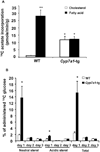
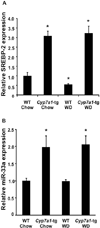
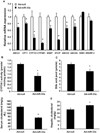
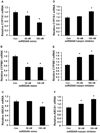
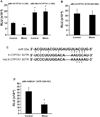

Similar articles
-
Overexpression of cholesterol 7α-hydroxylase promotes hepatic bile acid synthesis and secretion and maintains cholesterol homeostasis.Hepatology. 2011 Mar;53(3):996-1006. doi: 10.1002/hep.24107. Epub 2011 Feb 11. Hepatology. 2011. PMID: 21319191 Free PMC article.
-
Increased production of apolipoprotein B-containing lipoproteins in the absence of hyperlipidemia in transgenic mice expressing cholesterol 7alpha-hydroxylase.J Biol Chem. 2001 Jun 29;276(26):23304-11. doi: 10.1074/jbc.M101853200. Epub 2001 Apr 25. J Biol Chem. 2001. PMID: 11323427
-
Bile acid signaling in lipid metabolism: metabolomic and lipidomic analysis of lipid and bile acid markers linked to anti-obesity and anti-diabetes in mice.Biochim Biophys Acta. 2015 Jan;1851(1):19-29. doi: 10.1016/j.bbalip.2014.04.008. Epub 2014 May 4. Biochim Biophys Acta. 2015. PMID: 24796972 Free PMC article.
-
The pharmacological exploitation of cholesterol 7alpha-hydroxylase, the key enzyme in bile acid synthesis: from binding resins to chromatin remodelling to reduce plasma cholesterol.Pharmacol Ther. 2007 Dec;116(3):449-72. doi: 10.1016/j.pharmthera.2007.08.003. Epub 2007 Sep 7. Pharmacol Ther. 2007. PMID: 17959250 Review.
-
Regulation of cholesterol-7alpha-hydroxylase: BAREly missing a SHP.J Lipid Res. 2002 Apr;43(4):533-43. J Lipid Res. 2002. PMID: 11907135 Review.
Cited by
-
Cholesterol 7α-hydroxylase protects the liver from inflammation and fibrosis by maintaining cholesterol homeostasis.J Lipid Res. 2016 Oct;57(10):1831-1844. doi: 10.1194/jlr.M069807. Epub 2016 Aug 17. J Lipid Res. 2016. PMID: 27534992 Free PMC article.
-
A Recent Ten-Year Perspective: Bile Acid Metabolism and Signaling.Molecules. 2022 Mar 18;27(6):1983. doi: 10.3390/molecules27061983. Molecules. 2022. PMID: 35335345 Free PMC article. Review.
-
The Legacy of Infectious Disease Exposure on the Genomic Diversity of Indigenous Southern Mexicans.Genome Biol Evol. 2023 Mar 3;15(3):evad015. doi: 10.1093/gbe/evad015. Genome Biol Evol. 2023. PMID: 36726304 Free PMC article.
-
Bile acids and their receptors in hepatic immunity.Liver Res. 2025 Jan 28;9(1):1-16. doi: 10.1016/j.livres.2025.01.005. eCollection 2025 Mar. Liver Res. 2025. PMID: 40206435 Free PMC article. Review.
-
Molecular Pathogenesis of NASH.Int J Mol Sci. 2016 Sep 20;17(9):1575. doi: 10.3390/ijms17091575. Int J Mol Sci. 2016. PMID: 27657051 Free PMC article. Review.
References
-
- Lefebvre P, Cariou B, Lien F, Kuipers F, Staels B. Role of bile acids and bile Acid receptors in metabolic regulation. Physiol Rev. 2009;89:147–191. - PubMed
Publication types
MeSH terms
Substances
Grants and funding
LinkOut - more resources
Full Text Sources
Other Literature Sources
Medical
Molecular Biology Databases
Miscellaneous
